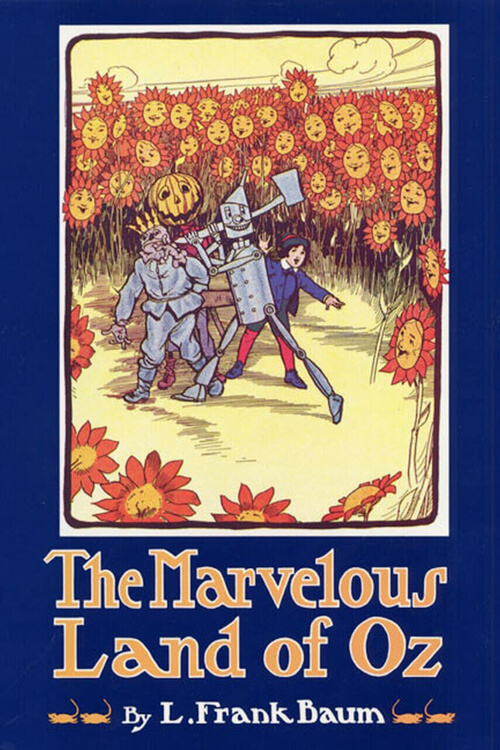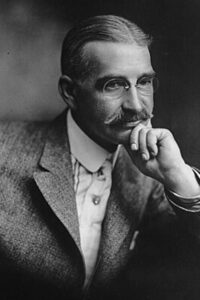
The Marvelous Land of Oz
In the Country of the Gillikins, which is at the North of the Land of Oz, lived a youth called Tip. There was more to his name than that, for old Mombi often declared that his whole name was Tippetarius; but no one was expected to say such a long word when “Tip” would do just as well.
This boy remembered nothing of his parents, for he had been brought when quite young to be reared by the old woman known as Mombi, whose reputation, I am sorry to say, was none of the best. For the Gillikin people had reason to suspect her of indulging in magical arts, and therefore hesitated to associate with her.
Mombi was not exactly a Witch, because the Good Witch who ruled that part of the Land of Oz
had forbidden any other Witch to exist in her dominions. So Tip’s guardian, however much she might aspire to work magic, realized it was unlawful to be more than a Sorceress, or at most a Wizardess.
Tip was made to carry wood from the forest so that the old woman might boil her pot. He also worked in the corn fields, hoeing and husking; and he fed the pigs and milked the four-horned cow that was Mombi’s especial pride.
But you must not suppose he worked all the time, for he felt that would be bad for him. When sent to the forest Tip often climbed trees for birds’ eggs or amused himself chasing the fleet of white rabbits or fishing in the brooks with bent pins. Then he would hastily gather his armful of wood and carry it home. And when he was supposed to be working in the corn fields, and the tall stalks hid him from Mombi’s view, Tip would often dig in the gopher holes, or if the mood seized him — lie upon his back between the rows of corn and take a nap. So, by taking care not to exhaust his strength, he grew as strong and rugged as a boy may be.
Mombi’s curious magic often frightened her neighbors, and they treated her shyly, yet respectfully, because of her weird powers. But Tip frankly hated her, and took no pains to hide his feelings. Indeed, he sometimes showed less respect for the old woman than he should have done, considering she was his guardian.
There were pumpkins in Mombi’s cornfields, lying golden red among the rows of green stalks; and these had been planted and carefully tended that the four-horned cow might eat of them in the wintertime.
Read or download Book
Lyman Frank Baum
Lyman Frank Baum (May 15, 1856 – May 6, 1919) was an American author best known for his children’s fantasy books, particularly The Wonderful Wizard of Oz, part of a series. In addition to the 14 Oz books, Baum penned 41 other novels (not including four lost, unpublished novels), 83 short stories, over 200 poems, and at least 42 scripts.
Biography.
He made numerous attempts to bring his works to the stage and screen; the 1939 adaptation of the first Oz book became a landmark of 20th-century cinema.
Born and raised in upstate New York, Baum moved west after an unsuccessful stint as a theater producer and playwright. He and his wife opened a store in South Dakota and he edited and published a newspaper. They then moved to Chicago, where he worked as a newspaper reporter and published children’s literature, coming out with the first Oz book in 1900. While continuing his writing, among his final projects he sought to establish a film studio focused on children’s films in Los Angeles, California.
His works anticipated such later commonplaces as television, augmented reality, laptop computers (The Master Key), wireless telephones (Tik-Tok of Oz), women in high-risk and action-heavy occupations (Mary Louise in the Country), and the ubiquity of clothes advertising (Aunt Jane’s Nieces at Work).
Later life and work
With the success of Wizard on page and stage, Baum and Denslow hoped for further success and published Dot and Tot of Merryland in 1901. The book was one of Baum’s weakest, and its failure further strained his faltering relationship with Denslow. It was their last collaboration. Baum worked primarily with John R. Neill on his fantasy work beginning in 1904, but Baum met Neill a few times (all before he moved to California) and often found Neill’s art not humorous enough for his liking. He was particularly offended when Neill published The Oz Toy Book: Cut-outs for the Kiddies without authorization.
Baum reportedly designed the chandeliers in the Crown Room of the Hotel del Coronado; however, that attribution has yet to be corroborated. Several times during the development of the Oz series, Baum declared that he had written his last Oz book and devoted himself to other works of fantasy fiction based in other magical lands, including The Life and Adventures of Santa Claus and Queen Zixi of Ix. However, he returned to the series each time, persuaded by popular demand, letters from children, and the failure of his new books. Even so, his other works remained very popular after his death, with The Master Key appearing on St. Nicholas Magazine’s survey of readers’ favorite books well into the 1920s.
In 1905, Baum declared plans for an Oz amusement park. In an interview, he mentioned buying “Pedloe Island” off the coast of California to turn it into an Oz park. However, there is no evidence that he purchased such an island, and no one has ever been able to find any island whose name even resembles Pedloe in that area. Nevertheless, Baum stated to the press that he had discovered a Pedloe Island off the coast of California and that he had purchased it to be “the Marvelous Land of Oz,” intending it to be “a fairy paradise for children.” Eleven-year-old Dorothy Talbot of San Francisco was reported to be ascendant to the throne on March 1, 1906, when the Palace of Oz was expected to be completed. Baum planned to live on the island, with administrative duties handled by the princess and her all-child advisers. Plans included statues of the Scarecrow, Tin Woodman, Jack Pumpkinhead, and H.M. Woggle-Bug, T.E. Baum abandoned his Oz Park project after the failure of The Woggle-Bug, which was playing at the Garrick Theatre in 1905.
His works anticipated such later commonplaces as television, augmented reality, laptop computers (The Master Key), wireless telephones (Tik-Tok of Oz), women in high-risk and action-heavy occupations (Mary Louise in the Country), and the ubiquity of clothes advertising (Aunt Jane’s Nieces at Work).






